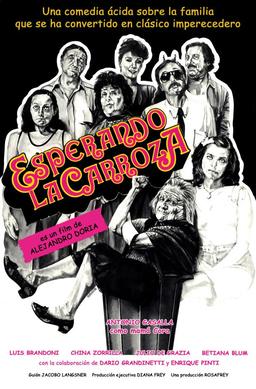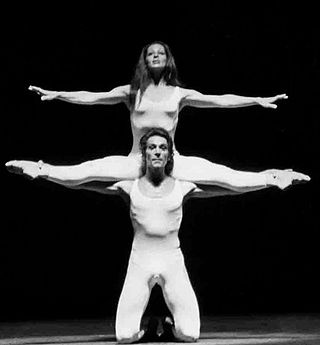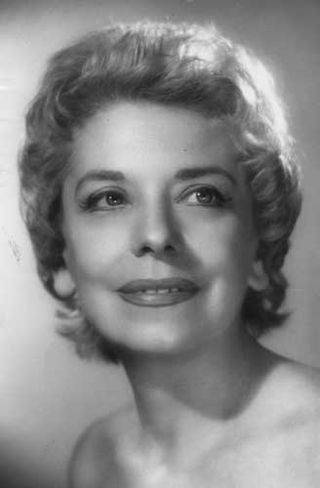Related Research Articles

Luisa Valenzuela Levinson is a post-'Boom' novelist and short story writer. Her writing is characterized by an experimental style which questions hierarchical social structures from a feminist perspective.

'Flora' Alejandra Pizarnik was an Argentine poet. Her idiosyncratic and thematically introspective poetry has been considered "one of the most unusual bodies of work in Latin American literature", and has been recognized and celebrated for its fixation on "the limitation of language, silence, the body, night, the nature of intimacy, madness, [and] death".

Waiting for the Hearse is a 1985 Argentine comedy film directed by Alejandro Doria. It is considered a cult film. It opened on 6 May 1985.

Yo también tengo fiaca is a 1978 Argentine sex comedy film directed by Enrique Cahen Salaberry. The film, produced by Hector Bailez, is based on Ricardo Talesnik's successful 1967 play of the same name and stars Susana Giménez and Juan Carlos Calabró as a middle-aged middle class couple committing infidelity.
Nicole Nau is a German dancer of Tango Argentino and Argentine folklore living in Argentina and Germany.
Olinda Bozán was an Argentine film actress and comedian of the Golden Age of Argentine Cinema (1940–1960). Born into a circus family, she acted on the vaudeville circuit, and performed in silent and sound movies. She was trained by the Podestá brothers, one of whom she married, who have one of the most prestigious Argentine acting awards named for them. Bozán' appeared in 75 films and was considered one of the best comic actors of Argentine cinema in the 20th century.

Susana Agüero was an Argentine ballet dancer who also danced in musicals and shows. She took a number of leading roles and worked for six years in France.

María Ruanova was an Argentine dancer, choreographer, teacher and ballet master, known for her performances at the Teatro Colón and internationally. She is considered the first Argentina-grown ballet dancer to gain international fame.
El Sonido de mi Tierra is a company from Argentina, for Tango Argentino and Folklore Argentino, founded by Luis Pereyra in 1996. "El Sonido de mi Tierra" means "The sound of my land". The Great Dance of Argentina is the international name of the same company, but used outside of Argentina and Spanish speaking countries. Both names are of the same company and same production.

Celia Geraldy was an Argentine vedette actress in film and theater. She was a femme fatale at the beginning of Argentina's golden decade of cinema.

Lolita Torres was an Argentine film actress and singer (contralto).

Quintana Saravia Haydée Mercedes, known as Mercedes Quintana was an Argentine classical dancer, choreographer, director and actress of stage, screen and television. She had a prominent stage career in Argentina in the 1930s. She appeared in films such as Yo quiero ser bataclana (1941), Ven... mi corazón te llama (1942) and Mujeres que bailan (1949).
Alicia Graciana Eguren was an Argentine teacher, poet, essayist and journalist.
Noemi Lia Lapzeson was an Argentine dancer, choreographer and educator. She received a Guggenheim Fellowship for the field of choreography in 1999.
Susana Naidich is an Argentine singer, musicologist, phonologist, voice teacher, and Speech-language pathologist. She was the founder and first president of the Argentinian Society of the Voice.

Ana Itelman was a Chilean-born dancer and choreographer, who spent most of her career in Argentina and the United States. Serving as a professor at Bard College and then director of the school of dance, she toured internationally between 1957 and 1969. In 1970, she returned to Argentina and established a contemporary dance theater. She was honored with the Konex Award for choreography in 1989.
Isa Soares is a Brazilian-born Argentine dancer and activist involved in creating awareness of the African traditions of Argentina and fighting racism against Afro-Argentine peoples. She was one of the pioneers in developing African dance interpretation and instruction in Argentina.
Graciela Gutiérrez Marx was an Argentine artist known for her speciality in mail art.
Ana Kamien is an Argentine dancer, choreographer, and actor who based most of her works in Buenos Aires, Argentina. Kamien was known for challenging gender and class norms along with creating works that parodied classical ballet by mixing the dance style with contemporary dance.
Sonia Sanoja was a Venezuelan dancer, teacher, choreographer, and poet, a pioneer of her country's dance scene in the 1950s and 60s, particularly in the area of contemporary dance.
References
- ↑ Chambers, Colin (2002). The Continuum Companion to Twentieth Century Theatre. London: A&C Black. p. 704. ISBN 0-8264-4959-X.
- ↑ "Susana Zimmermann". www.bottega2000.it. Retrieved 2021-09-10.
- ↑ Llumá, Agustina. "In memoriam: Susana Zimmermann | Balletin Dance, La Revista Argentina de Danza" (in Spanish). Retrieved 2021-09-10.
- 1 2 Zimmermann, Susana (2007). Cantos y Exploraciones: Caminos de Teatro-Danza (in Spanish). Buenos Aires: Balletin Dance. pp. 18, 20. ISBN 978-987-22748-5-6.
- 1 2 3 "Falleció la coreógrafa y bailarina Susana Zimmermann | Argentores". argentores.org.ar. Retrieved 2021-09-14.
- ↑ Fortuna, Victoria (2019). Moving Otherwise: Dance, Violence, and Memory in Buenos Aires. New York: Oxford University Press. p. 35. ISBN 978-0-19-062702-7.
- ↑ Zimmermann, Susana. "Dore Hoyer: A Body Labyrinth of Space" (PDF). The Magdalena Project.
{{cite web}}: CS1 maint: url-status (link) - ↑ Kowal, Rebekah J.; Siegmund, Gerald; Martin, Randy (2017). The Oxford Handbook of Dance and Politics. New York, NY: Oxford University Press. p. 391. ISBN 978-0-19-992818-7.
- ↑ "Dancing politics in Argentina". OUPblog. 2018-12-23. Retrieved 2021-09-14.
- 1 2 Fortuna, Victoria (2019). Moving Otherwise: Dance, Violence, and Memory in Buenos Aires. New York: Oxford University Press. p. 32. ISBN 978-0-19-062701-0.
- ↑ Craine, Debra; Mackrell, Judith (2010). The Oxford Dictionary of Dance. Oxford: Oxford University Press. p. 20. ISBN 978-0-19-956344-9.
- 1 2 "Murió la bailarina y coreógrafa Susana Zimmermann, una de las figuras del Di Tella - LA NACION". La Nación (in Spanish). ISSN 0325-0946 . Retrieved 2021-09-14.
- ↑ "Conferencia ::Susana Zimmermann: Cantos y exploraciones del cuerpo ::Instituto Cervantes de Milán". milan.cervantes.es. Retrieved 2021-09-13.
- ↑ "Susana Zimmermann – Catálogo de Autores (Argentores)" (in European Spanish). Retrieved 2021-09-13.
- ↑ Fortuna, Victoria (2019). Moving Otherwise: Dance, Violence, and Memory in Buenos Aires. New York: Oxford University Press. p. 210. ISBN 978-0-19-062702-7.
- 1 2 Holmberg, Arthur; Solorzano, Carlos (2014). World Encyclopedia of Contemporary Theatre: Volume 2: The Americas. Oxon: Routledge. p. 43. ISBN 0-415-05929-1.